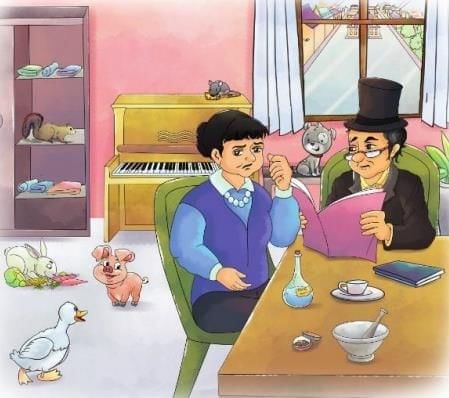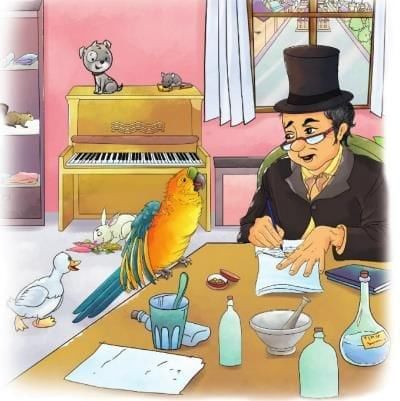Doctor Dolittle Chapter Notes | English Class 4 ICSE PDF Download
| Table of contents |

|
| Introduction |

|
| Key Points |

|
| Explanation |

|
| Message |

|
Introduction
The chapter "Doctor Dolittle" is an exciting story about a doctor named John Dolittle who lived a long time ago in a small town. He was not like other doctors because he loved animals more than people and kept many pets in his home. Over time, he discovered that animals have their own special way of talking, and his clever parrot, Polynesia, helped him learn it. This story shows how his love for animals led him to change his life and become a doctor just for them, teaching us about kindness and understanding.
Key Points
This story is about:
- John Dolittle was a qualified doctor living in Puddleby-on-the-Marsh.
- He had many pets like goldfish, rabbits, mice, a squirrel, a hedgehog, a duck, a dog, a baby pig, a parrot, and an owl.
- His sister, Sarah, was unhappy because the animals made the house messy and scared away sick people.
- He lost most of his human patients and became poor because he spent money caring for his pets.
- The Cat's-meat-Man and Polynesia suggested he should treat animals instead of people.
- Polynesia revealed that animals have their own language and taught him bird words.
- He started writing down the animal language with Polynesia’s help on a rainy afternoon.
Explanation
John Dolittle was a well-trained doctor (M.D.) who lived in a quiet town called Puddleby-on-the-Marsh. He was known for his big heart and love for animals. His home was full of pets, including goldfish in a pond, rabbits in the food storeroom, white mice living inside his piano, a squirrel in the big cupboard, and a hedgehog in the underground room.

His favorite animals were Dab-Dab the duck, Jip the dog, Gub-Gub the baby pig, Polynesia the parrot, and Too-Too the owl. His sister, Sarah Dolittle, often complained because these animals made the house look untidy and kept sick people away. She told him that because of the animals, they were getting poorer, and the rich people would stop coming for treatment. But Dolittle replied that he liked animals more than those "best people."
As days passed, fewer people visited him, and soon his only patient was the Cat's-meat-Man, who didn’t mind the animals. This man came once a year with a small silver coin for medicine, which was not enough to live on. To feed his growing number of pets, Dolittle sold his piano and let the mice live in a drawer. He even sold his best Sunday suit, and his money kept running out.
People in the town noticed his old clothes and holes in his stockings, but the dogs, cats, and children still followed him because they loved him. One day, while the Cat's-meat-Man visited with a stomach ache, he suggested Dolittle become an animal doctor since he knew so much about them. Polynesia, who was singing by the window, agreed and told Dolittle that animals can talk.

She spoke bird words like "Ka-ka oi-ee, fee-fee," meaning "Is the porridge hot yet?" This surprised Dolittle, and he quickly got a notebook and pencil. That rainy afternoon, Polynesia taught him the bird language slowly, and this was how he began to understand that animals have their own way of communicating.
Message
The story teaches us to be kind to animals and recognize that they have feelings too. It shows that choosing to help and love animals can be more rewarding than focusing on money or pleasing others. Dolittle’s decision to learn their language encourages us to connect with nature and care for it.
New Words with Meanings
- M.D.: A title that means Doctor of Medicine, showing he was a real doctor.
- Pantry: A special room where food and kitchen tools are kept.
- Closet: A large cupboard for storing things like clothes.
- Hedgehog: A small animal with sharp spines on its back for protection.
- Cellar: An underground room used to store items.
- Grumble: To complain or say unhappy things.
- Sixpence: An old silver coin that was worth a little money.
- Bureau-drawer: A piece of furniture with drawers for keeping clothes or other items.
- Vet: A doctor who takes care of sick animals.
FAQs on Doctor Dolittle Chapter Notes - English Class 4 ICSE
| 1. What are the main themes explored in the Doctor Dolittle series? |  |
| 2. How does Doctor Dolittle's ability to talk to animals impact his adventures? |  |
| 3. What role does the character of Doctor Dolittle play in promoting animal welfare? |  |
| 4. In what ways does the narrative style of Doctor Dolittle contribute to its appeal for readers? |  |
| 5. How has Doctor Dolittle influenced popular culture and literature? |  |














